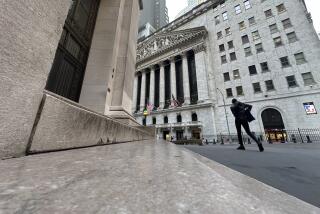Stocks avoid a fourth straight losses
The stock market sputtered to an indecisive close Thursday, taking a pause after three straight days of losses.
Small company stocks, which have slumped 10 percent from their early-July peak into what’s known as a “correction,” recovered the most.
Thursday’s pause followed what has been tough spell for the market, including the Dow Jones industrial average’s 238-point drop Wednesday and a weak September. The buying may have reflected people stepping into the market to take advantage of the recent declines, a trend of “buying on the dip” that has kept the market rising all year despite various geopolitical shocks and worries about Europe’s flagging economy.
Stocks had been sharply lower most of the day, only to recover in the last couple of hours of trading. The Dow had been down as much as 130 points.
“People have been waiting a long time to get back in, and I think (the declines in September) created an entry point for the cash on the sidelines to start buying again,” said Aaron Jett, an equity strategist at Bel-Air Investment Advisors, which focuses on investing for high net-worth individuals.
The Standard & Poor’s 500 index was effectively unchanged on the day, rising one one-hundredth of a point to close at 1,946.17. Technically, the S&P 500’s ever-so-slight gain let it avoid a fourth straight day of declines, which would have been the first time that has happened since December 2013.
The Dow fell 3.66 points, or 0.02 percent, to 16,801.05 and the Nasdaq composite rose 8.11 points, or 0.2 percent, to 4,430.19.
The Russell 2000 index, which tracks small-company stocks, gained 1 percent, far more than the S&P 500 and the Dow. The Russell entered into what’s known as a “correction” on Wednesday, which is when a stock index falls 10 percent or more for a recent high.
“People are willing to dip their toes back in,” Jett said.
The price of crude oil and energy stocks, which had also been through a rough patch, recovered as well.
Oil had slumped earlier in the day, helping to drag energy and other stocks lower, but ended up recovering all of its losses by the close of trading. Benchmark U.S. crude oil rose 28 cents to $91.01 a barrel in New York. It fell to $88.18 at one point, its lowest level since April of 2013.
Oil had been on multi-week slide after OPEC announced it would keep oil production at its current levels despite a weakening global economy and a glut in world oil supplies. Lower oil prices are by and large good for the average U.S. consumer because it translates into lower gas prices. But lower oil prices also hurt the profitability of energy companies, which make up a large part of the U.S. stock market.
Airline stocks also made a modest recovery after sliding Wednesday. United Continental rose 66 cents, or 1.5 percent, to $46.13, Delta Air Lines was up 38 cents, or 1 percent, to $35.28 and Jet Blue rose 34 cents, or 3 percent, to $10.59. The airlines got beaten down Wednesday on fears that the news of the first diagnosed case of Ebola in the U.S. might curtail demand for travel.
“Confirmation of a case of Ebola in the U.S. has joined a growing list of bad news stories with geopolitical tensions in Ukraine and Hong Kong, and growth concerns around China and Europe,” said Niall King of CMC Markets in a commentary.
Even with the modest gains, the general direction of the U.S. market in recent weeks has lower. The biggest point of concern for investors has been Europe, and once again, those concerns flared up on Thursday.
European stock markets sank following comments from European Central Bank President Mario Draghi, who said the bank would keep interest rates at record-low levels and start a bond-buying program to help boost economic demand. The program’s details were limited, causing investors to hit the “sell” button across the continent.
“(Draghi) missed an opportunity today to greatly expand (the bank’s economic stimulus programs) and he blew it,” said Doug Cote, chief market strategist at Voya Investment Management.
Germany’s DAX lost 2 percent, France’s CAC-40 index fell 2.8 percent and the United Kingdom’s FTSE 100 fell 1.7 percent. Some of Europe’s riskier stock markets, such as Spain and Italy, were down as much as 4 percent.
Europe’s economic weakness has been a problem for U.S. investors for several weeks now. U.S. companies sell goods globally and if Europe’s economic slowdown were to continue, it could hit company’s profits.
Wall Street did have one bit of positive economic news to work through. The number people seeking U.S. unemployment benefits dropped 8,000 last week to 287,000, the lowest level in more than eight years. Overall, 2.3 million people are receiving unemployment benefits, the fewest since June 2006.
Investors are waiting for the closely watched monthly jobs report, released Friday by the Labor Department. Economists expect U.S. employers added 215,000 workers in September and the unemployment rate remained at its current level of 6.1 percent.
In other markets, U.S. government bond prices fell slightly. The yield on the 10-year Treasury rose to 2.43 percent. In metals trading, the price of gold fell 40 cents to $1,215.10 an ounce, silver fell 21 cents to $17.05 an ounce and copper fell four cents to $3 a pound.
In other energy futures trading on the NYMEX, wholesale gasoline fell 4.1 cents to close at $2.409 a gallon, heating oil fell 1.8 cent to close at $2.638 a gallon and natural gas fell 9.1 cents to close at $3.932 per 1,000 cubic feet.
More to Read
Inside the business of entertainment
The Wide Shot brings you news, analysis and insights on everything from streaming wars to production — and what it all means for the future.
You may occasionally receive promotional content from the Los Angeles Times.










